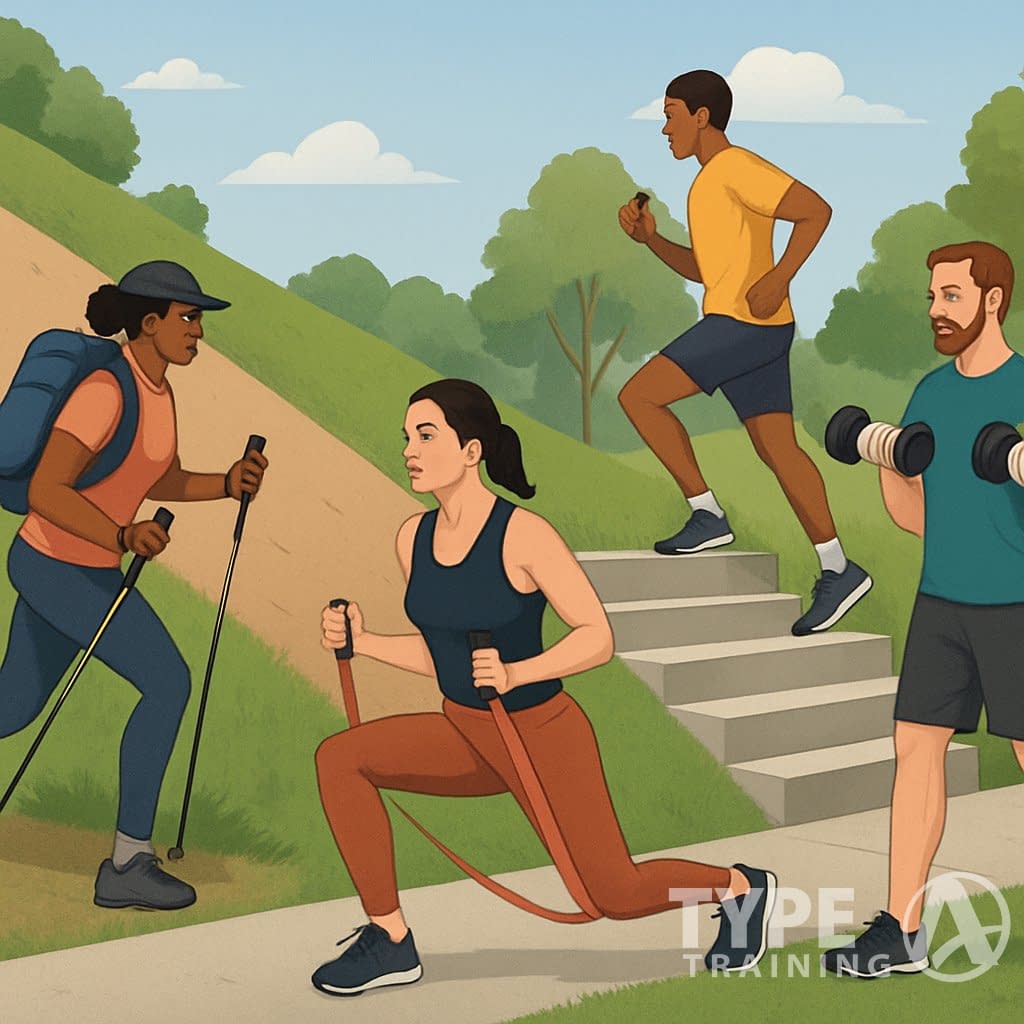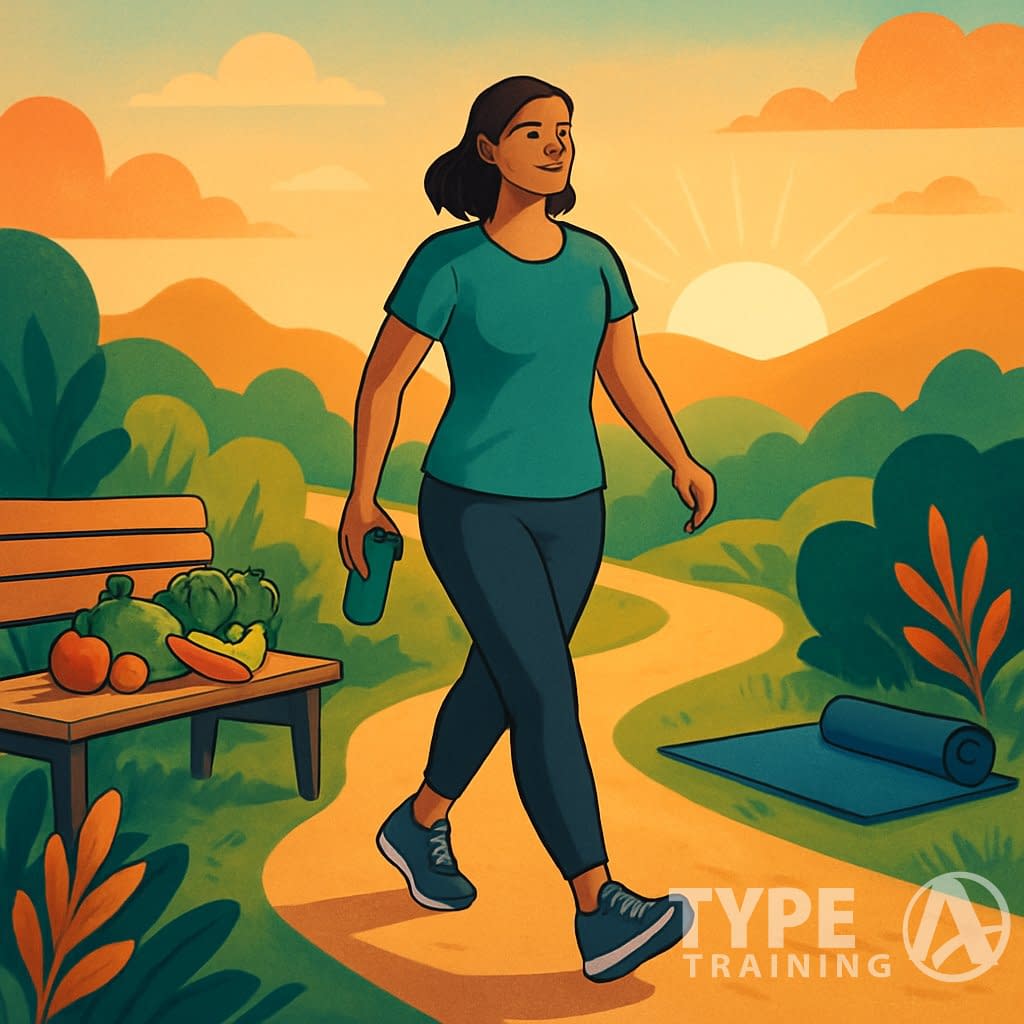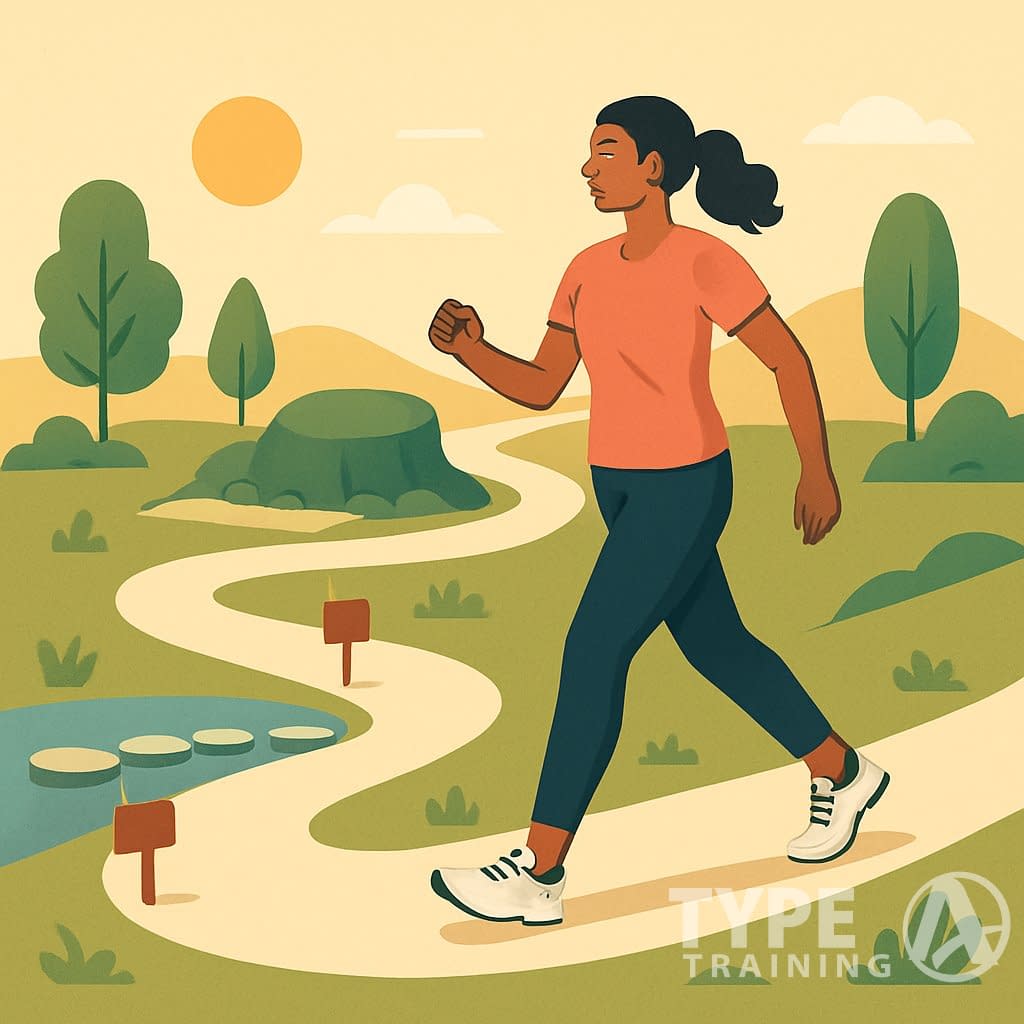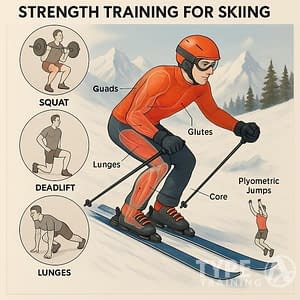Walking is a fantastic way to kick off your fitness journey. But at some point, your body catches on.
Maybe that usual route feels almost effortless now. Your heart rate barely budges, and you’re not even breaking a sweat.
This is what folks call a fitness plateau. It just means you’ve gotten efficient at your current activity—nothing weird about it.

Popular posts:
To bust through a walking plateau, you’ll need to shake things up with walking plateau strategies. Try adding hills, upping your pace, or tossing in intervals of jogging.
Incorporating these walking plateau strategies into your routine can make a significant difference in your progress.
Implementing walking plateau strategies can help you regain momentum in your fitness routine and break through any stagnation you may be experiencing.
Switch things around sometimes, too. Variety keeps your body from getting too cozy.
Don’t let a plateau get you down. If anything, it’s a win—your body’s tougher now.
Fine-tuning your technique can push you forward, not just raw effort. Sure, walking more still helps, but adding strength training and gradually increasing difficulty really makes the difference.
Key Takeaways
- Plateaus show you’ve adapted and need new challenges to keep progressing.
- Add intensity with hills, intervals, or different routes to break through.
- Pair walking with strength training for a fuller fitness plan.
Understanding Walking Plateaus

A walking plateau happens when your body gets too good at your current routine. Progress slows or even stalls out.
Your body loves adapting. That’s why you need to keep things interesting if you want to keep improving.
What Is a Fitness Plateau?
A fitness plateau means you’re not seeing changes, even though you’re sticking with your regular walks. Weight loss might stall, endurance doesn’t budge, and you just don’t feel pushed.
This is totally expected. Every fitness journey has fast progress at first, then periods where things seem stuck.
It’s like your body’s way of saying, “Hey, I’ve got this down.” Plateaus are proof your first plan worked.
If you’ve been walking the same route at the same pace for weeks and nothing’s changing, you’re probably at a plateau.
Why Plateaus Happen During Walking
Your body’s built for efficiency. When you start walking, you burn more calories and your heart and muscles work hard.
But those big gains slow down after a while.
A few things cause these plateaus:
- Efficiency improvements: Muscles and heart get better at the job, so you burn less energy.
- Same old routine: Walking the same distance and speed just doesn’t cut it anymore.
- Metabolic adaptation: Your body figures out how to do the work with fewer calories.
Basically, your body wants to save energy. Once it nails your routine, it stops changing.
It’s amazing for survival, but not so much for chasing fitness goals.
The Role of Adaptation in Walking Progress
Adaptation is your body’s answer to stress. When you start walking, your body has to work.
Over time, it gets stronger and more efficient.
Here’s how it usually goes:
- Initial challenge: New walks feel tough.
- Adaptation: Your body gets better at handling it.
- Easy mode: What was hard now feels simple.
- Plateau: Progress stalls unless you switch things up.
To keep progressing and dodge plateaus, you’ve got to keep adding new challenges. Your body only changes when it has to.
Knowing this gives you the power to make real changes. Just tweak your routine, and you’ll get moving again.
Recognizing When Walking Gets Too Easy
When your body adapts to your walks, things start to feel too easy. Spotting these plateaus is the first step to getting back on track.
Signs You’ve Hit a Walking Plateau
Your body’s actually pretty blunt about it. If you finish a walk without sweating or feeling tired, you’ve probably adapted.
Heart rate is another clue. If your old route doesn’t really get your heart pumping anymore, you’re at a plateau.
Weight loss stalling out? That’s a classic sign too.
Boredom counts. If you’re dragging your feet to get out the door, your mind probably wants a change as much as your body does.
Common plateau signs:
- No sweat, no huffing and puffing
- Walks feel like a breeze
- Weight loss has flatlined
- Motivation drops
- Muscles don’t feel worked afterward
Measuring Progress and Performance
Tracking your walks helps you see what’s really going on. Use a fitness tracker or an app to watch your distance, pace, and calories.
Heart rate zones matter. For good cardio, you want to hit 60-70% of your max heart rate. If you’re always below that, you’re coasting. Time to shake things up.
Keep a quick journal of your perceived effort from 1-10. If you’re always at 5 or less, it’s time to boost the intensity.
Notice how fast you recover after walks. If you’re back to normal in a minute, your body’s gotten stronger and needs a new push.
Check your numbers against where you started. It’s a good way to see if you’re stuck or still moving forward.
Setting New Goals for Continued Progress
If your walks feel like autopilot, it’s time for new goals. The right targets can spark motivation and give you something to chase.
Establishing Advanced Fitness Goals
When walking gets easy, you’ve got to up the ante. Fresh goals keep things interesting and help you avoid ruts.
A few ideas:
- Distance milestones: Add about 10% more distance each week.
- Time challenges: Try to finish your usual route a couple minutes faster.
- Tougher terrain: Hills, stairs, or rougher paths make a difference.
- Events: Sign up for a 5K or a charity walk for some extra spark.
Make your goals specific. Instead of “walk more,” aim for “12,000 steps a day for three weeks.” That way, you know when you’ve nailed it.
How to Set and Track Realistic Improvements
Start with where you’re at, and set goals that actually feel doable. Tracking progress is huge for keeping your head in the game.
Tracking tools:
- Fitness watches or apps
- Old-school notebook or journal
- Marking days on a calendar
Break big goals into bite-sized ones. If 10 miles sounds wild, start with 3, then 5, then 7.
Celebrate the mini wins along the way. Little goals keep things fun.
Check in every month or so. If you’re crushing your goals, ramp it up. If not, dial it back a little.
Sometimes you just have to trust the process. Progress isn’t always straight.
Effective Strategies to Break Through Plateaus
If walking feels like a snooze, it’s time to stir things up. Routines make your body lazy, and that’s where plateaus sneak in.
Increasing Workout Intensity
Just walk faster. Seriously, picking up the pace is one of the easiest ways to bust a plateau.
Try interval training—walk at your normal speed, then switch to power walking for a bit, then back down. It keeps your body guessing.
Find some hills. Walking uphill burns way more calories and wakes up new muscles. Thirty minutes up a hill can torch up to 60% more calories than flat ground.
Weighted options:
- Throw on a weighted vest (start light, maybe 5-10% of your weight)
- Carry small hand weights (1-3 lbs each)
- Try ankle weights (1-2 lbs each)
Don’t go wild with the weights right away. Keep your form solid to avoid injuries.
Varying Your Walking Routine
Change the scenery when you can. New neighborhoods, parks, or trails can make walking feel fresh.
Mix in these walking moves:
- Backward walking: Good for balance and different muscles
- Side steps: Hits your hips and thighs
- High knees: Gets your heart rate up
- Walking lunges: Builds strength and stability
Switch up your schedule, too. If you always walk in the morning, try after dinner.
Your body reacts differently at different times, and that little change can kickstart progress.
Track your walks with an app or pedometer. Watching your steps or distance go up is weirdly satisfying.
Incorporating Gym Equipment
Treadmills are great for controlling the challenge. Crank up the incline or use preset interval programs for a tougher workout.
Try these treadmill routines:
- Incline intervals: Two minutes at 4% incline, one minute at 1%, repeat.
- Speed intervals: Three minutes easy, one minute fast, repeat.
- Progressive: Bump up the speed by 0.2 mph every three minutes.
Ellipticals are a solid low-impact swap that work more of your upper body. They’ll wake up muscles you might not hit outside.
Stair climbers and steppers break plateaus fast. Even ten minutes can leave your legs talking.
Honestly, sometimes you just have to try something new and see what gets you excited to move again.
Building Strength and Endurance Beyond Walking
When walking feels too easy, it’s time to shake things up. Your body craves new challenges to keep improving fitness and health.
Add resistance and mix up the intensity to give your muscles and heart something fresh to tackle.
Adding Strength Training to Support Walking
Strength training builds the muscle support system that makes walking smoother and more powerful. Focus on moves that hit your lower body, core, and posture muscles.
Try these bodyweight exercises two or three times a week:
- Squats: 2-3 sets of 10-15 reps
- Lunges: 2-3 sets of 8-12 reps per leg
- Calf raises: 2-3 sets of 15-20 reps
For your upper body and core, add:
- Planks (start with 20-30 seconds)
- Push-ups (go for modified if needed)
- Dumbbell rows
Switching things up keeps your body guessing and prevents hitting a plateau. Start light and increase the weights as you get stronger.
Building muscle also boosts your metabolism, which can help burn more fat even when you’re not working out.
Integrating Endurance-Based Workouts
If you want more endurance than walking alone gives, it’s smart to mix in other cardio. Your heart and lungs will thank you.
Try these endurance workouts:
- Interval training: Alternate one minute of brisk walking with 30 seconds of jogging. Building both strength and stamina helps you progress.
- Cross-training: Add low-impact activities like swimming or cycling once or twice a week. You’ll hit different muscle groups and keep things interesting.
- HIIT workouts: Short, intense bursts of exercise with rest periods can ramp up your aerobic capacity fast. Try a 15-minute session once a week to start.
To boost endurance, bump up your workout duration by about 10% each week. Tracking progress with a fitness app or a simple journal can help you stay motivated.
Supporting Progress Through Nutrition and Recovery
Your walking routine needs solid fuel and smart recovery. These two things work together to help your body keep up with tougher challenges.
Optimizing Nutrition for Energy and Muscle Recovery
You need the right nutrients to keep making gains from your walks. Aim for a balanced mix of all macronutrients to fuel your body.
Protein needs: Get 0.5-0.8g of protein per pound of body weight daily to support muscle repair. Lean meats, eggs, dairy, beans, and plant-based proteins all work well.
Carbohydrates for energy: Go for complex carbs like whole grains, fruits, and veggies. They’ll keep you going during longer, tougher walks.
Timing matters: Try to eat a small meal with both protein and carbs within 30-45 minutes after a hard walk to maximize recovery.
Anti-inflammatory foods like berries, fatty fish, and turmeric can help your body bounce back faster.
The Role of Hydration in Performance
Water keeps your walking performance and recovery on track. If you’re dehydrated, walks feel way harder and your energy tanks.
Daily hydration target: Aim for at least 64oz (8 cups) of water a day, and more if you’re active. If your urine is pale yellow, you’re probably good—darker means drink up.
Pre-walk hydration: Drink 16-20oz of water two to three hours before your walk, then another 8oz about 15 minutes before you start.
During longer walks: For anything over an hour, bring water and sip regularly. If you’re out for 90+ minutes, a sports drink can help replace lost electrolytes.
Post-walk: Rehydrate with 16-24oz of fluid for every pound lost during exercise.
Prioritizing Rest and Active Recovery
Your body gets stronger during rest, not during the workout itself. Skipping recovery just sets you up for plateaus or injuries.
Sleep quality: Get 7-9 hours of quality sleep. This is when your body repairs muscles and produces growth hormone. Skimping on sleep can stall your progress.
Active recovery days: Mix in lighter activity between tough walks. Try gentle yoga, swimming, or just a casual stroll to boost blood flow without overdoing it.
Listen to your body: If you’re always tired, sore, or your performance is dropping, you probably need more rest. Don’t shrug it off.
Stress management: High stress slows down recovery. Make time for meditation, deep breathing, or whatever helps you chill out.
Avoiding Common Pitfalls and Staying Consistent
As your walking routine gets harder, you’ll hit some bumps in the road. Knowing how to handle them helps you keep moving forward and actually enjoy the journey.
Preventing Overtraining and Fatigue
Pushing yourself is great—until it’s not. Overtraining can stop your progress in its tracks.
Warning signs of overtraining:
- Muscle soreness that just won’t quit
- Feeling wiped out, even after sleep
- Motivation in the tank
- Resting heart rate higher than normal
Make sure you’re taking rest days. Those aren’t wasted—they’re when your body repairs and gets stronger.
Active recovery like gentle stretching or yoga can help on these days.
Eat enough protein after walks and keep up with hydration to support recovery.
The Importance of Patience and a Positive Mindset
Progress isn’t always a straight line. Some weeks you’ll crush it; other times, it feels like nothing’s changing.
Track more than just distance or time. Notice things like:
- How you feel during and after walks
- Your resting heart rate
- Sleep quality
- Day-to-day energy
Mindset tricks that help:
- Celebrate the little wins
- Focus on showing up, not being perfect
- Use positive self-talk when things get tough
Plateaus happen to everyone. They’re not failure—they’re just your body adjusting.
Staying Engaged with the Fitness Community
Staying connected with others can make a huge difference in motivation. Find walking partners or join a group for accountability and a little fun.
Online communities are great if you can’t meet in person. Check out:
- Walking challenges on apps
- Social media groups for fitness walkers
- Virtual walking events
Share your ups and downs. Sometimes hearing someone else’s story sparks your own breakthrough.
If you’re really stuck, think about working with a fitness professional. A fresh perspective can help you break through a rut.
Maximizing Results With Professional Guidance
When you hit a plateau, expert guidance can make all the difference. Sometimes you just need a nudge in the right direction, or a plan that’s actually tailored to you.
Working with a Personal Trainer
A personal trainer brings know-how and fresh eyes to your walking program. They’ll assess your fitness level and spot any weak links.
Trainers design custom walking workouts, tweaking your technique for better results. Maybe you need to fix your posture, arm swing, or foot placement—details you might not notice alone.
Having someone hold you accountable helps a lot. Most people push a bit harder when someone’s watching.
Trainers know when to add interval training or weighted walks, so you don’t get stuck doing the same thing forever.
Objective feedback can be a game changer. Trainers catch things you miss and suggest exercises for those stubborn weak spots.
Creating a Periodized Plan for Long-Term Success
Periodization breaks your walking program into phases, each with a different focus. This approach keeps your body adapting and helps avoid plateaus.
Your plan might look like this:
- Base phase: Build endurance with longer, easier walks
- Intensity phase: Add hills, speed bursts, or resistance
- Recovery phase: Let your body rest and adapt
- Performance phase: Combine everything to reach your best
Breaking through rehabilitation plateaus often takes this kind of step-by-step progression. It’s tempting to do too much too fast, but steady increases work better.
Track your progress in each phase. Adjust as needed—some phases might need more time, others less, depending on how you feel.
Utilizing Mobility Work and Foam Rolling
Limited mobility can really sabotage your walking progress. Tight muscles and stiff joints make your body move in awkward ways that waste energy and bump up your risk of injury.
Regular foam rolling helps break through plateaus by releasing tension in key walking muscles like calves, hamstrings, and quads. I usually spend about one or two minutes on each muscle group before heading out.
Mobility exercises focus on the ankle, hip, and thoracic spine. All of these matter for smooth, efficient walking.
Try ankle circles and calf stretches. Throw in some hip flexor stretches and glute activations.
Thoracic rotations and extensions also help a ton. I’d recommend doing mobility work every day, not just on days you walk.













